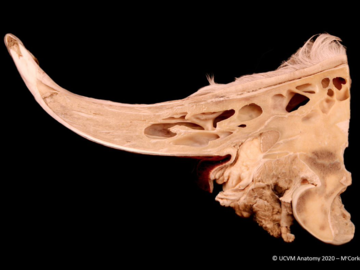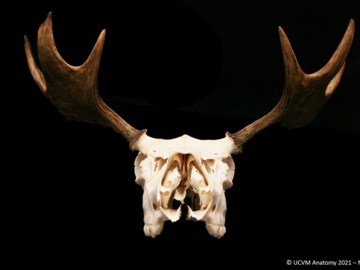
Anatomy: Zoo and Wildlife

Welcome to wildlife anatomy!
We will be learning about the anatomy of birds, reindeer, muskox, and some other small mammals! We will be going through some of the important anatomical adaptations that reindeer and muskox have.
Avian Anatomy
Avian Anatomy Overview
Watch this video to learn more about the anatomy of the bird!
Avian Skeletal Anatomy
Watch this video to review the important structures of the avian skeleton!
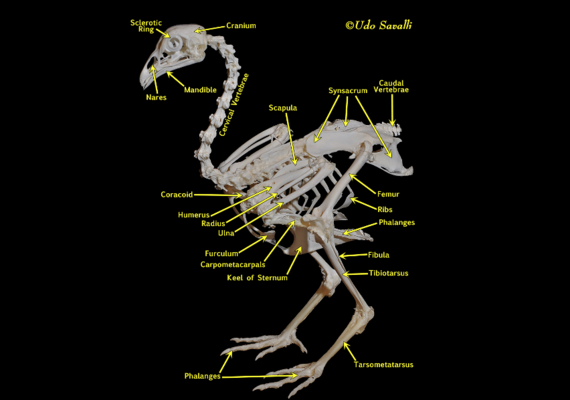
Flying Adaptations
Birds have become specially adapted for flight, meaning that many parts of their body have been designed specifically to allow them to fly. Most of these adaptions make the bird's body lighter. For example, birds have hollow bones that are very light!
Look at the bird skeleton to the left, what differences can you see compared to the large and small animals we have learned about this week?

Avian Muscles
There are 2 very important muscles that birds use to beat their wings and create flight.
These muscles are called the pectoralis and the supracoracoideus muscles. When the pectoralis muscles contracts the wing produces a powerful downbeat. When the supracoracoideus muscles contracts the wing produces movements for takeoff. However when both these muscles relax the wing produces the movements for an upstroke.
Image Credit: Dyce, Sack, and Wensing 2018
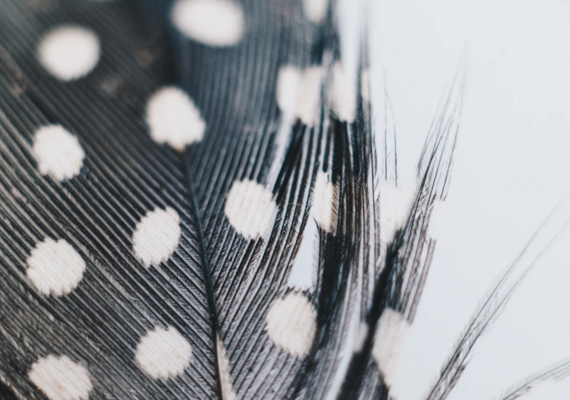
Light as a feather
In order to be lighter for flight, birds lack teeth, have hollow bones, a light and simple digestive tract, and lay eggs instead of carrying their chicks inside of their bodies. Flying is a lot of work so in order to achieve flight they also have very efficient lungs and hearts!
Birds also use their feathers to help them fly! Feathers are not just for flight though, because they also play roles in warmth, protection, attracting mates, and camouflage!

Feathers
Did you know that birds only grow feathers on their skin along specific tracks called pteryla? Apteryla indicates the parts of the bird's skin without feathers.
Types of Feathers:
Flight feathers - Birds have these on their wings and tails. Flight feathers have long shafts and barbules that help increase their strength of flight.
Down feathers - Birds use these for insulation because the feathers are soft and fluffy with little to no shaft and are able to trap air.
Contour feathers - Birds use these feathers to give their bodies shape, color, and some insulation. These are found everywhere except the beak, legs, and feet.
Image Credit: http://www.sahasbarve.com/blog-mountain-birds-wear-down-jackets

Digestive System
The digestive system of the bird is designed to be light so it is less complex than some of the other systems that we have learned about this week.
Some unique organs of the bird's digestive system include the following:
- The crop is an organ that resides along the esophagus and acts as a storage place for food.
- The proventriculus is a simple stomach that has acid similar to our stomach to digest food.
- The ventriculus (gizzard) is a specialized sac that birds fill with small stones that they use to mechanically grind down their food.

Reproduction
Within a female bird, there are different parts of their reproductive system that make each part of the egg. The eggs you can buy at the grocery store are unfertilized eggs (meaning they don’t contain a developing chick) from laying hens!
Did you know that in order to remain light for flight female birds only have a reproductive system on their left side? A way to remember this is "only the left is left".
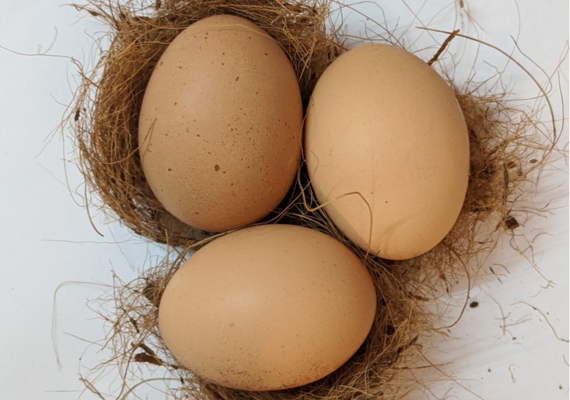
Laying Hens
Inside the abdomen of a laying hen, there are a bunch of round, yellow structures called follicles that become the yolk! The follicles move from the ovary, where they grow, into a tubular structure called the oviduct. In the first part of the oviduct, the thick part of the egg white or albumin is added to the yolk. As it continues down, the rest of the thinner albumin is added! The developing egg then reaches a structure called the shell gland where the shell is added. This part takes the longest to add and can take up to 20 hours! Once the egg has a shell, it moves into the vagina where a coating called the bloom or cuticle is added. This layer protects the egg from bacteria. In North America, we wash off this layer and so we have to refrigerate our eggs to keep them safe to eat. In places like Europe, they leave the bloom on and that's why they don’t have to refrigerate their eggs!
Unique Bird Adaptions
Lots of Species Variation
There are around 10,000 different species of birds with lots of variation within each species. A chicken looks very different from an ostrich, peacock, or hummingbird! Read more to see some of the cool adaptions that make birds look so different from one another!

Owls
Owls are very interesting birds. Did you know that owls have a visual field of 110 degrees? Owls can spin their heads around and even turn them upside down! Since owls have no teeth, they will swallow their food whole or tear it up with their sharp beaks before swallowing it. They have a two-part stomach and any food they cannot digest is turned into a pellet that the owl can regurgitate (throw up). Don't worry thought, this process doesn't hurt them at all!
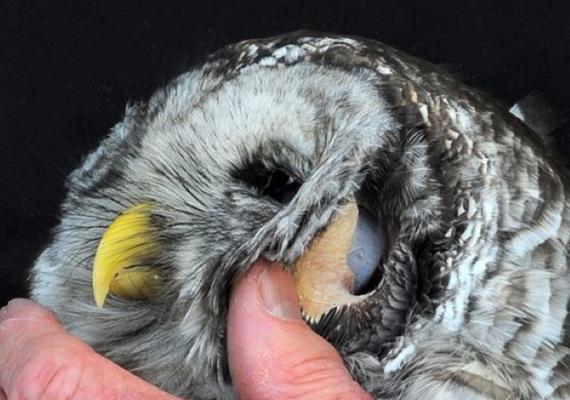
How do Birds Hear Noise?
Owl ears are actually just holes in their heads. If you look into an owl ear you can actually see the back of their eyes and sometimes even their optic nerve! In this photo you can see the back of the owl's eye when looking through their ear! Owl ears are also different heights which allows them to differentiate where sounds are coming from!

Hawks
Red-tailed hawks are among the largest raptors in the world with a wingspan of 4 feet. Like all hawks, they have excellent vision, enhancing their ability to find prey, especially from far distances. Hawks also have strong sharp talons to help them catch prey and curved beaks to help them rip and tear pieces of meat.

Peregrine Falcons
Peregrine falcons are the fastest bird in the world. They are specially adapted for speed during flight, are very agile and able to dive dramatically and quickly. These birds are able to reach speeds up to 320 kilometres per hour while diving toward prey!

Turkeys
Turkeys are funny looking and sounding birds. They also have very odd names for some of their facial features! Although the names of these facial features might be funny, they are important for attracting mates!
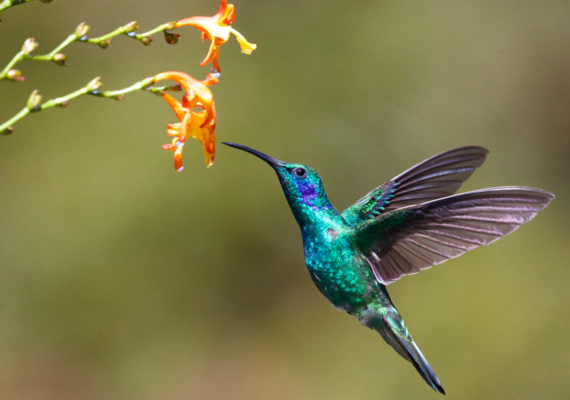
Humming Birds
Hummingbirds are very tiny and unique birds. They are so small that their heart rate is ~1260 beats per minute!! This means that the metabolism of a hummingbird is extremely fast, so much so that they have to go into a special state, similar to hibernation, called torpor during their sleep to slow down their metabolism.
Hummingbirds are also the only bird able to hover during flight! They are able to achieve this by beating their wings very quickly and efficiently in a unique figure eight motion.
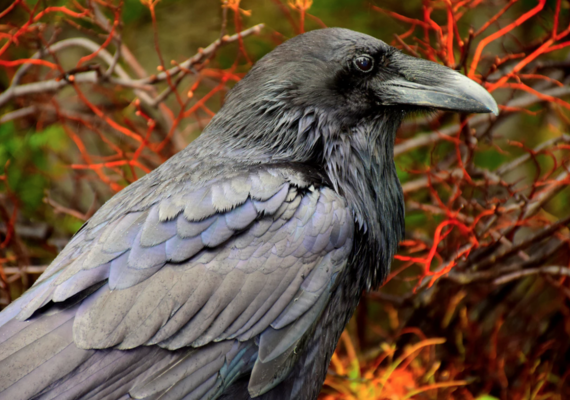
Ravens
Ravens are large black birds that belong to the family Corvidae. They are one of the largest corvids. They are omnivorous and highly opportunistic.
Ravens are highly intelligent and have the largest brain of any bird species. They are one of only four animals that are able to communicate about objects or events in distant space or time. They are excellent problem solvers, as they can be seen often using tools and easily solving puzzles.

The California Condor
The California Condor is a new world vulture. It is the largest bird with the longest wingspan in North America. If that isn't impressive enough, it is also one of the world's longest living birds, living up to 60 years! It is considered to be critically endangered due to poaching, habitat destruction, and poisoning. This condor species remains one of rarest birds in North America.
California condors lack a syrinx, the body part of the bird that produces sound, therefore they are limited to hisses and grunts. In order to tackle the heat of the hot climates they live in, these birds have developed a special process called urohidrosis where they defecate on their legs to cool down.
Image Credit: https://hips.hearstapps.com/hmg-prod.s3.amazonaws.com/images/ata040621condors-img01-1614016602.jpg
Reindeer and Muskox
Staying Warm in the North
Have you ever wondered how animals such as reindeer or muskox stay warm in the arctic? Watch the video below with Dr. Muench to find out!
Antlers vs. Horns
Not sure what the difference between an antler and a horn is? Watch the video below where Dr. Muench explains the difference and shows you some cool specimens!
Antlers
Learn more about antlers and how they are shed in the below video with Dr. Muench!
Unique Wildlife Anatomy

Stinky Skunks
Skunks have a special adaption that you are probably aware of... In order to defend themselves from predators or bothersome dogs or humans, skunks are able to spray a foul smelling liquid chemical as a deterrent. The skunk's white stripes also act as a warming sign to predators that they are able to defend themselves. However, skunks do not spray without warning. If you see a skunk hissing, raising its tail, arching and turning its back towards you, and stomping their front feet, beware and run!
Skunks have two glands on each side of their anus that produce and store the foul smelling liquid chemical that skunks are able to spray out of the glands when needed, with good accuracy up to 3 meters! They can store enough chemicals in their glands for up to 5 to 6 sprays.

Racoon Hygiene
Did you know that raccoons wash their food before they eat it? They actually do this to increase their ability to feel their food to tell what it is and if they should eat it! Raccoons are omnivores and very non-discriminate eaters and will eat almost anything... but they'll wash it first!
Did you also know that raccoons are one of the primary carriers of rabies? So if you see a raccoon, you should avoid touching or interacting with it! Although their black face masks make them look like cute bandits, please stay away from them!

Ground Squirrels
Ground squirrels have special cheek pouches in which they are able to store their food and babies when needed. These cheek pouches have their own blood supply and can be everted easily from their mouths!
Squirrels also have a special ability to rotate their hind feet so they can descend down trees head first. This special ability not only helps them move along and between trees, but it can also be advantageous when reaching for food or avoiding predators.
Squirrels also have a really good sense of smell, which helps them find their food and rediscover food they have hidden/stored.
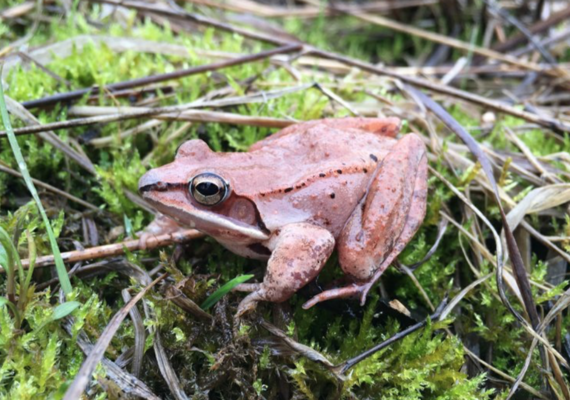
Wood Frogs
Wood frogs have a very cool adaption that allow them to survive Canadian winters. During winter, wood frogs allow ice crystals to form inside their bodies, around their cells, becoming completely frozen solid! When completely frozen solid, they are unable to breath, their heart does not beat, and they do not move, but they are still alive. Although becoming frozen solid would be lethal to most other animals, wood frogs are able to simply unthaw during the spring without any damage. They unthaw from the inside out, first unthawing their heart so it can begin beating! They are very cool frogs... literally!

Moose
Moose are the largest and heaviest members of the deer family. They live in forests of the northern hemisphere in sub-arctic climates. Thus, they are specially adapted for cold weather with thick skin and a dense heat retaining coat. Their very large size also helps reduce the amount of heat they lose. Male moose have distinctive antlers, which they use to defend themselves and attract mates.
Although generally slow moving and sedentary they can become very aggressive. Due to their very large size and aggression, they are very dangerous.
Fun Fact: Moose are great swimmers and can dive up to 6 meters for aquatic vegetation!
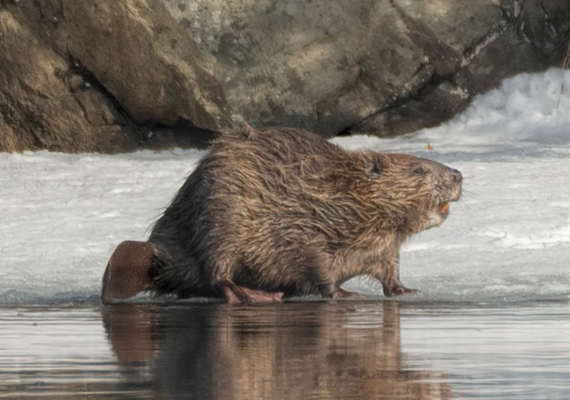
Beavers
Beavers are semi-aquatic animals. They have fat scaly tails that act as fat reserves for long winters. They can also slap their tails on water as a warning.
Beavers have orange incisors that continuously grow and need to be warm down by gnawing and chewing. Their incisors appear orange due to a protective iron heavy coating of enamel on their teeth. Beavers use their incisors to chop wood from trees to build their dams and lodges. They don't eat a lot of wood, only the bark and soft layers of wood from trees, in addition to other vegetation. They are herbivores, and like horses and cows, have special microbes in their guts that help them digest these materials!
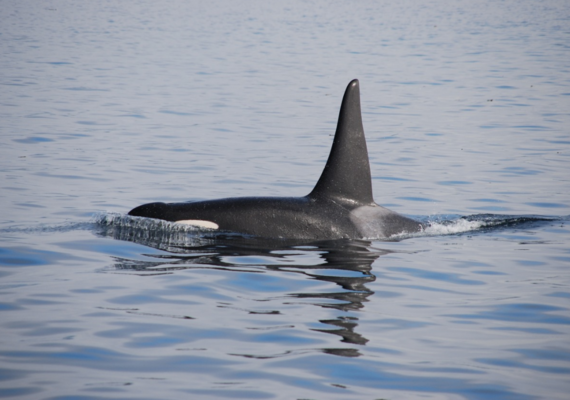
Killer Whales
Killer whales or Orcas are huge aquatic predators found all over the world's oceans. These beautiful black and white whales can be between 6-10 meters long and 8000-22000 pounds heavy. Adult orcas have no natural predators, can swim up to 40km/hr and hold their breath for up to 15 minutes.
Orcas live in social groups called pods that can either be transient or resident. These pods hunt together, and their diets consist of a wide variety of fish and aquatic species such as mammals, depending on their species and lifestyle. Did you know that moose and deer make up a portion of some orca species diets, as they can be eaten when diving for vegetation in the ocean?
Zoo Animal Anatomy

Hippopotamus
A hippopotamus can weigh between 1500 and 3200 kg when they are full grown! Hippos have pores on their skin that excrete a thick, oily substance that is a red and orange colour that acts as a natural sunscreen. This is sometimes called "blood sweat", but it has no actual blood in it! These herbivorous animals have short stumpy legs, webbed feet and are actually almost completely hairless. Fun fact: they will lose water in dry air at a rate four times greater than a human!

Hippo Teeth
Hippos have two pairs of tusks on their lower jaw and very large mouth that can open 1.2 meters! They are considered semi-aquatic mammals and can stay under water for long periods of time, between 3-5 minutes. Hippos have nostrils that are located on the top of their head that will actually close as an adaptation for being under water! Hippos will even sleep underwater and will rise up above water and breathe without ever waking up! Hippos have canine teeth that can be almost 30 inches long. You can see the canine teeth in this image of a hippo skull that we are lucky enough to have at UCVM.
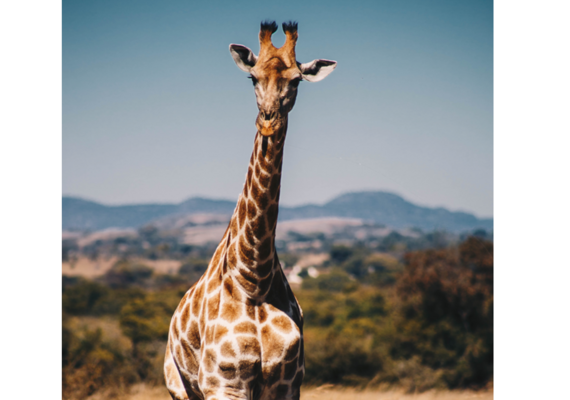
Giraffes
Giraffes have two ‘bumps’ on the top of their heads are called ossicones, which are anatomically different than horns seen in other species. These ossicones function in helping to regulate body temperature and can also be used in male battles. One of the most characteristic features of the giraffe is their long and powerful neck. It is important to remember though that like all other mammals, giraffes only have 7 cervical vertebrae. However, these vertebrae are much larger compared to the cervical vertebrae of other mammals such as dogs. As a result of their long necks, the blood has a very long distance to travel. Due to this, giraffes have a higher concentration of red blood cells, as well as more valves in their blood vessels to help control blood flow.
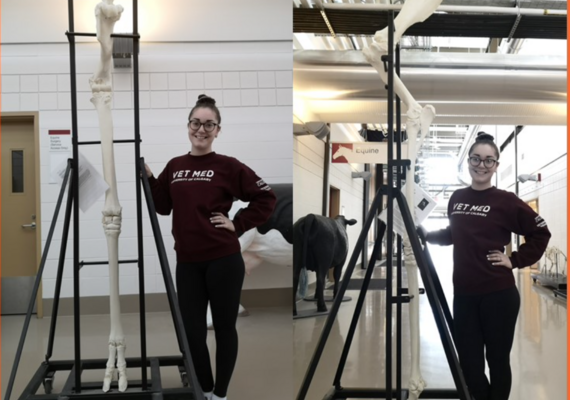
Giraffe Skeleton
Giraffes are very unique in their body structure and composition compared to other terrestrial mammals. They are actually the tallest of the terrestrial mammals and can weigh between 1800-2600 pounds! Their legs are extremely long and powerful and contribute to the giraffe’s height. Interestingly, when giraffes are using their walking gait, they will move both legs on the same side at the same time.

Elephants
As you may know, elephants have strong, long trunks. Their trunks are an extension of their nose, with two nostrils along its whole length, that they use to complete many tasks. Their trunk is very muscular, agile, and sensitive. They use their trunks for breathing, smelling, handling objects, snorkelling, and much more.
Elephants also have sharp tusks that are extensions of their incisor teeth that they use to dig, carry things, defend themselves, and more.
Their large ears are useful to keep themselves cool, but they also act as a signalling tool to communicate.
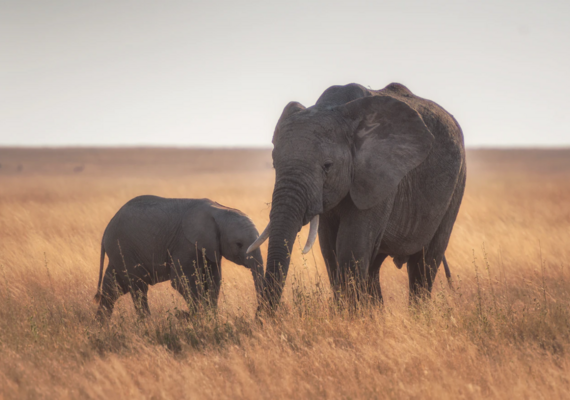
Elephant Brains
Elephants are incredibly intelligent beings. Their brains are the largest of any land animal, and 4x the size of an adult human's brain. The female elephant's brain is slightly smaller than the males, however, they are considered more intelligent.
Elephants live in matriarchies, in which an elder female is the leader of the herd and guides her family to food, resources, and safety. Elephants have very close-knit social bonds. They remember friends, and celebrate when they see old friends. They also grieve and have funerals for their lost loved ones. They have been seen deliberately stopping and touching elephant skeletons or staying with the bodies of their deceased loved ones. Sadly, all elephant species are considered to be critically endangered due to poaching and habitat fragmentation and destruction.

Zebras
Zebras are equine species from Africa with distinct black and white striped coats. They are part of the family Equidae, along with horses and donkeys.
Their unique coat is thought to have a protective function by confusing and disorientating pests and predators, making it hard for them to focus and land on one specific zebra. There are also theories that these stripes help with heat regulation, individual recognition, and much more.
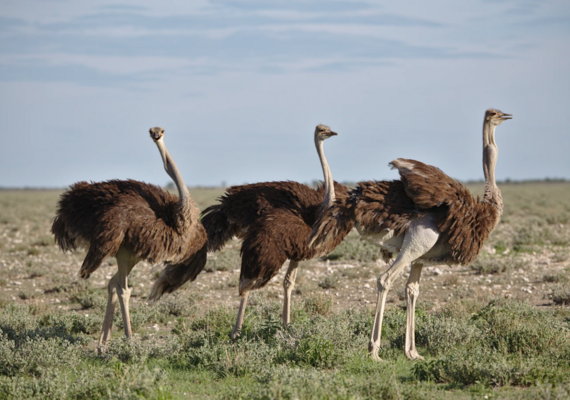
Ostriches
Ostriches are the largest flightless birds in Africa. They are one of the more ancient bird species. They also lay the largest eggs of any bird species in the world.
Rather than being built for flight, ostriches are built for high speed running with very long legs and long necks. Ostriches can run up to 70km per hour making it the fastest two legged animal!
One myth about ostriches is that they do not actually bury their heads in the sand!

Snow Leopards
Snow leopards live in the mountain ranges of central and south Asia. These panther relatives are unfortunately listed as a species that are vulnerable to extinction, as their global population is declining.
The snow leopard has several adaptions for life in the cold mountains of Asia, such as rounded ears that minimize heat loss, broad paws with fur tufts to help efficiently walk on snow without slipping, a dense fur coat for warmth, and a long tail to help balance when moving along the rocky mountain side.

Tigers
Tigers are the largest living cat belonging to the panther family. They are known for their distinctive orange and black stripes and white underside. Tigers are carnivores whose primary prey are deer and wild boar. Although they are social animals, they often live by themselves in solitude within very large territories. Tigers are considered to be an endangered species due to population decline from poaching and habitat fragmentation and destruction.
It is theorized that tigers use their orange and black stripes as a form of camouflage. Although their bright orange colour does not seem to blend into their lush green environment to us, their prey are red-green colorblind. This means that to their prey, their bright orange appears green, perfect for blending into their surroundings long enough to approach and pounce on their prey!

Quokka
Quokkas, otherwise known as the short-tailed scrub wallaby, are small marsupials from Australia that are around the size of a domestic cat. Although it almost looks like a small kangaroo, it can climb trees and shrubs. These nocturnal herbivores need to drink lots of water, which can be hard when living in a desert-like Australia, but they solve this problem by eating lots of vegetation! Quokkas have earned the reputation as the world's happiest animals because they are so approachable and smiley that they willingly take adorable selfies with people!
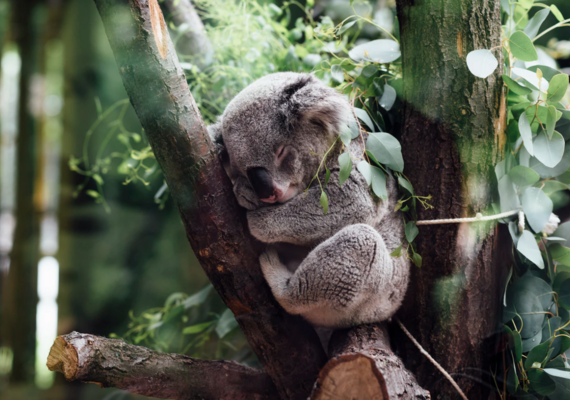
Koala
Koalas are another herbivorous marsupial from Australia. Their diet consists of primarily eucalyptus leaves! However, eucalyptus leaves are not very nutritious or calorically dense so koalas live a sedentary life, sleeping up to 20 hours a day.
The koala has one of the smallest brains relative to body weight of any mammal. They also have a very primitive brain. This may be a result of their limited nutrient and caloric intake. Subsequently, they are unable to adapt to changes. For example, koalas will not eat eucalyptus leaves that are plucked and lying on the ground.

Ring Tailed Lemurs
Ring tailed lemurs are native to southwestern Madagascar. They are herbivores that live in social groups. These lemurs have 13 alternating white and black stripes on their tail which is used like a flag to communicate with each other. They also use facial expressions and calls to communicate making them one of the most vocal primates.
They have special scent glands are their wrists and chest that they use to mark their foraging routes. Additionally, the males have a spur on their wrist they use to pierce trees before marking.

Gorillas
Gorillas are ground-dwelling herbivorous apes that live in the forests of Africa. They are the largest non-human primates. They live in groups called troops, each of which has a dominant alpha male leader, called a silverback. They are one of the most endangered species in the world and all species of gorilla are considered critically endangered due to poaching, habitat destruction, and disease. Gorillas have adapted to walk on all 4 legs by "knuckle walking" in which they hold their fingers on their forelimbs in a flexed position allowing body weight to press down to the ground on their knuckles. Alternatively, they can walk short distances standing up on their hindlimbs! Gorillas are highly intelligent animals. They use tools like sticks to gauge water depth and fish for termites. Captive gorillas have even been taught to effectively communicate with sign language!


